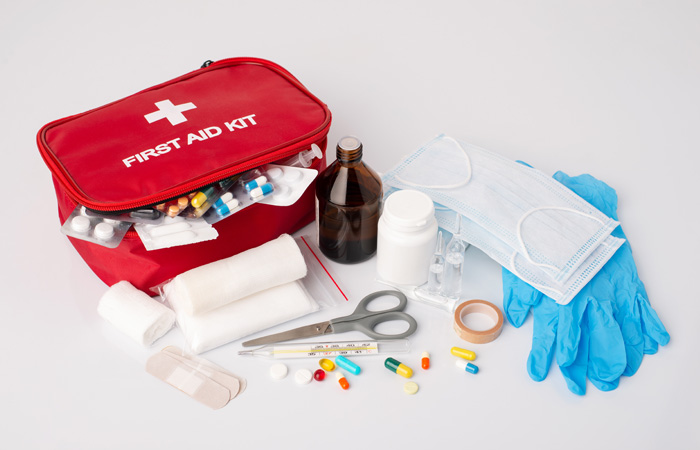Accidents will happen...
In Practice
Follow this topic
Record learning outcomes
There has been an accident involving a car and a motorcycle not far from your pharmacy. You are expected to go and help – but do you have the necessary skills?

Learning objectives
After reading this feature you should be able to:
• Appreciate the role of pharmacists in first aid provision to the general public
• Understand the importance of a moist environment to optimise wound healing
• Offer practical first aid advice on treating minor injuries and wounds with OTC products available from the pharmacy.
Any first aid course or training that is undertaken should give community pharmacists the necessary skills to assess and identify the nature of emergency situations and take appropriate action, including referral where appropriate.
As a minimum, the GPhC says, first aid training for pharmacists should cover:1
- Obstruction to airways
- CPR
- Shock
- Electric shock
- Overdoses and poisoning
- Seizures
- Hypo or hyperglycaemia
- Loss of consciousness
- Severe bleeding
- Burns and scalds
- Head injuries and concussion
- Severe head, chest or abdominal pain
- Allergic reactions.
The GPhC also stipulates pharmacist-focused training for situations that need first aid but are not usually life-threatening such as minor allergic reactions, foreign bodies or chemicals in the eye, mild shock, minor burns and scalds, injuries to bones, muscles, joints, and minor bleeding.
Pharmacists can meet this required standard by attending a first aid course delivered by a recognised provider such as St John Ambulance. Numerous other first aid training providers also offer both online and in-person first aid courses. Examples include the Ofqual-approved First Aid for Life, which offers specialist training for pre and post-registration pharmacists and Onlinefirstaid.com, which provides CPD- verifiable first aid at work courses for community pharmacists.
Although all new pharmacists should be ready to take on a first aid role if needed, some pharmacies may prefer to designate specific members of staff to act as first-aiders and handle any health emergency situations if they arise. Registered first-aiders can then also provide training and assessments for pre-registration pharmacists if required. It is important to ensure that skills and knowledge remain up-to-date for any designated first-aider and that professional indemnity insurance is in place to cover any first aid activities that may be carried out in a community pharmacy setting.
Are you ‘first aid confident’? Tell us at: pm@1530.com
First aid kits
Pharmacists can help to raise public awareness and knowledge of first aid by displaying first aid posters in their pharmacy, ideally in areas where products for minor wounds and injuries can be purchased. This also links to the importance of first aid kits, which are critical when responding quickly to any emergency health situation. St John Ambulance advises that all homes and cars should have an adequate and appropriately stocked first aid kit containing sterile dressings, adhesive dressings/plasters, bandages and protective items such as disposable gloves and face masks.2 Additional useful items include cleansing wipes, gauze pads, adhesive tape, scissors, pins and clips, and an aluminium blanket.
All of these items should be available to buy direct from the pharmacy and placed in a waterproof container in an easily accessible place that all household/staff members are aware of.
While designated first-aiders in the pharmacy may be best equipped to counsel customers on the finer points of first aid, all pharmacy staff can help to improve knowledge among the population at large by signposting to key sources of advice and further information. The St John Ambulance website features advice on a range of first aid topics and includes videos illustrating how to perform potentially life-saving techniques such as CPR and defibrillation, as well as more basic first aid tips such as how apply a dressing or plaster, how to put on a bandage, how to use a cold compress and how to make a sling.
A pocket-sized guide to essential first aid is also available free of charge via the St John Ambulance website and customers should be encouraged to download their free first aid app, which is available for Android or iPhone mobile devices. This provides easy-to-follow advice for dealing with a range of first aid scenarios including CPR, diabetic emergencies, choking and allergic reactions. All the information is hosted on the app so no internet access is required – making it suitable for use in any emergency situation in the home or further afield.

Key facts
• All pharmacists should be aware of the key principles of emergency first aid
• An appropriately stocked first aid kit is essential when responding to emergency health situations in both the home and workplace
• Wound care has evolved over the past two decades, driven by a better understanding of the physiology of wound healing
Optimal wound healing
Minor wounds such as cuts and burns are common everyday injuries requiring first aid intervention. Better understanding of the physiology of wound healing over the past two decades has driven a sea change in the optimal approach to caring for such wounds, from dry to wet.
Wound healing involves four key stages, which are delicately balanced and intricately linked:
- Haemostasis
- Inflammation
- Proliferation
- Maturation.3
Although these stages typically take place in a step-wise linear sequence, wounds can also progress backwards or forwards through the healing process depending on internal and external patient factors.3 Keeping wounds moist has been shown to promote re-epithelialisation and lead to less scar formation compared to a dry environment.
A moist environment also helps dampen down the inflammatory reaction thereby limiting progression of the initial injury. Several studies have compared different healing micro- environments and conclusively shown that the moist setting is best for providing the fastest healing with fewest complications and least scar formation.4
GPhC standard on first aid
The General Pharmaceutical Council performance standard C2.10 states that all pharmacist trainees should be able to demonstrate awareness of emergency first aid.1 Such training should ideally be maintained by all pharmacists, with additional specialist training provided for those responsible for vaccinations.
“The public expects a pharmacist to be able to help if there is an accident or emergency near the pharmacy or in the pharmacy itself,” says the GPhC. “It also expects a pharmacist to be an appropriate person to phone for advice in an emergency.”
OTC wound care
For pharmacists, understanding the key principles of good wound care is critical as many people with minor cuts, grazes and burns will turn to the pharmacy for help. For most minor cuts or grazes, OTC treatment with a plaster or non-adhesive wound dressing held in place with a bandage or adhesive tape is appropriate. Plasters are available both as traditional adhesive plasters or spray formats, which are particularly useful for awkward places such as the elbows and knees.
Spray plasters work by forming a transparent, breathable, flexible film over the wound, which both protects and promotes natural healing. They do not need to be removed or washed off and will gradually disappear over time. Customers can be reassured that a slight stinging on application is normal but use should be discontinued if persistent irritation occurs and spray plasters should never be used on deep or weeping wounds or burns.
Non-adherent wound dressings are designed not to stick to the drying secretions of the wound, making them easier to remove with less pain and risk of damage to the newly-healing skin. It is important to ensure the correct size of dressing is used so that it covers beyond the edges of the wound.
Moist dressings are specifically formulated to keep the wound micro-environment at optimal moisture levels for healing. There are two key types:
- Hydrogel dressings composed of up to 70 per cent water plus other ingredients, held in a viscous gel
- Hydrocolloid dressings that do not contain moisture themselves but form a seal at the wound surface that blocks evaporation of fluid from the skin.5
Treatment options in this area include hydrogel plasters, which create a moist environment within the wound and also benefit from a cool, wet-feeling gel to relieve discomfort (e.g. from burns). Several OTC hydrocolloid plasters and dressings are also available that maintain moist conditions under the dressing, thereby reducing hard scab formation, minimising scarring and promoting healing.
Moist wound dressings are also recommended for the treatment of more complex wounds such as the necrotic type, while absorbent dressings (e.g. alginate, hydrofibre and foam) may be required for exudative wounds.6 These types of wounds are beyond the scope of OTC management and affected customers should be referred to their GP surgery for further advice.
Skin closures can be purchased OTC and are recommended for deeper cuts to close and secure the wound. They help to keep the edges of the wound in place to reduce the risk of reopening and subsequent scarring. For additional protection against infection, the affected area can be covered with a sterile or antiseptic dressing.
Vapour permeable films are another option for the management of superficial wounds such as minor cuts, abrasions and burns, and shallow pressure sores. These transparent adhesive films provide a moist wound healing environment for minor wounds and burns, and also benefit from being conformable and extensible.
Beyond their first aid remit, pharmacists also have a key role to play in managing chronic wounds such as diabetic foot ulcers, pressure ulcers, and venous and arterial leg ulcers. Specifically, pharmacists can help to promote adherence to prescribed dressing regimens, recommend analgesics for pain relief and offer advice on how to manage the underlying problem and prevent recurrence.
As with acute wounds, it is important to be aware of culprit medications that can exacerbate chronic wounds, including sedatives that reduce patient movement and encourage pressure sores to develop, and nicorandil and hydroxyurea, which are associated with ulcer formation.6
Overly frequent dressing changes should be avoided as this can prove traumatic to the skin and also increase pain as the wound comes into contact with the air
Wound healing complications
It is important to be alert for customers in whom wound healing may be impaired or delayed. This includes elderly people who often have thin skin and patients with underlying medical issues such as diabetes (especially if poorly controlled) or significant cardiovascular disease. Ideally, these patients should be encouraged to seek more specialist advice from a GP or practice nurse.
Certain medications can also hamper the wound healing process, notably anticoagulants, which reduce haemostasis and increase the risk of haematoma, and corticosteroids (both topical and oral), which interfere with the fibroblasts that orchestrate the proliferative phase of wound healing.6
References
- General Pharmaceutical Council (GPhC). Pre-registration manual Available at: C. Medicines and Health | GPhC
- St John Ambulance. Available at: First aid courses, advice & volunteering | St John Ambulance
- Wound Source. The four stages of wound healing. Available at: The Four Stages of Wound Healing | WoundSource
- Junker J et al. Clinical impact on wound healing and inflammation in moist, wet and dry environments. Adv Wound Care. 2013; 2(7):348-356
- Beldon P et al. How to choose the appropriate dressing for each wound type. Wound Essentials. 2010; 5:140-144
- Bennett-Marsden M. How to select a wound dressing. Pharmaceutical Journal. 1 Nov 2020
